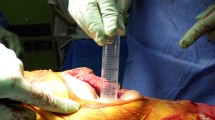Abstract
Introduction
Surgical instrument contamination during total joint replacement is a matter of major concern. Available recommendations suggest changing suction tips, gloves and avoiding light handle manipulation during the procedure. There is a paucity of data regarding surgical gown contamination. The aim of the present study was to evaluate the contamination rate of surgical gowns (SGs) during total hip arthroplasty (THA) and secondarily compare it with other orthopedic procedures.
Materials and methods
One hundred and forty surgical gowns (from 70 surgeries) were screened for bacterial contamination using thioglycolate (a high-sensitivity culture broth). The THA contamination rate was compared with those of knee and spine procedures. Controls were obtained at the beginning of every surgery and from the culture broth. The procedure’s duration and the level of training of the surgeon were evaluated as potential risk factors for contamination.
Results
Bacterial contamination was identified on 12% of surgical gowns (22% of surgical procedures). The contamination rate during THA was 4.1% (2% in primary THA and 8.3% in revisions) vs 21.67% during other surgeries (spine and knee) (OR 6.15, p = 0.012). There were no contaminated SGs during THAs performed in ≤ 2 h (0/33 SGs) vs 7.5% (3/40) for THAs that took ≥ 2 h (p = 0.25).
Conclusion
There was a high rate of SG contamination during orthopedic procedures that was higher during non-arthroplasty procedures and prolonged THAs. There were no contaminated surgical gowns in THAs under 120 min, efforts should point keeping primary THAs under this cutoff time. As a general recommendation, SGs should be changed every time there is concern about potential contamination.

Similar content being viewed by others
References
Robinson ANH, Drew S, Anderson J et al (1993) Suction tip contamination in the ultraclean-air operating theatre. Ann R Coll Surg Engl 75:254–256
Beldame J, Lagrave B, Lievain L et al (2012) Surgical glove bacterial contamination and perforation during total hip arthroplasty implantation: when gloves should be changed. Orthop Traumatol Surg Res 98:432–440. https://doi.org/10.1016/j.otsr.2011.10.015
Abdelaziz H, Zahar A, Lausmann C et al (2018) High bacterial contamination rate of electrocautery tips during total hip and knee arthroplasty. Int Orthop 42(4):755–760
Schweitzer D, Klaber I, Fischman D et al (2015) Surgical light handles: a source of contamination in the surgical field. Acta Orthop Traumatol Turc 49:421–425. https://doi.org/10.3944/AOTT.2015.14.0401
Davis N, Curry A, Gambhir AK et al (1999) Intraoperative bacterial contamination in operations for joint replacement. J Bone Jt Surg Br 81:886–889. https://doi.org/10.1302/0301-620X.81B5.9545
Bullock MW, Brown ML, Bracey DN et al (2017) A bundle protocol to reduce the incidence of periprosthetic joint infections after total joint arthroplasty: a single-center experience. J Arthroplasty 32:1067–1073. https://doi.org/10.1016/j.arth.2016.11.028
Learmonth ID, Young C, Rorabeck C (2007) The operation of the century: total hip replacement. Lancet 370:1508–1519. https://doi.org/10.1016/S0140-6736(07)60457-7
Parveen S, Kaur S, David SA et al (2011) Evaluation of growth based rapid microbiological methods for sterility testing of vaccines and other biological products. Vaccine 29:8012–8023. https://doi.org/10.1016/j.vaccine.2011.08.055
Bible JE, Biswas D, Whang PG et al (2009) Which regions of the operating gown should be considered most sterile? Clin Orthop Relat Res. https://doi.org/10.1007/s11999-008-0341-1
Cheng H, Chen BP-H, Soleas IM et al (2017) Prolonged operative duration increases risk of surgical site infections: a systematic review. Surg Infect (Larchmt) 18:722–735. https://doi.org/10.1089/sur.2017.089
Hosseini P, Mundis GM, Eastlack R et al (2016) Do longer surgical procedures result in greater contamination of surgeons’ hands? Clin Orthop Relat Res 474:1707–1713. https://doi.org/10.1007/s11999-016-4832-1
Dalstrom DJ, Venkatarayappa I, Manternach AL et al (2008) Time-dependent contamination of opened sterile operating-room trays. J Bone Jt Surg Ser A 90:1022–1025. https://doi.org/10.2106/JBJS.G.00689
Kaya I, Uǧrafi AA, Sungur I et al (2012) Glove perforation time and frequency in total hip arthroplasty procedures. Acta Orthop Traumatol Turc. https://doi.org/10.3944/AOTT.2012.2660
Aalirezaie A, Akkaya M, Barnes CL et al (2019) General assembly, prevention, operating room environment: proceedings of international consensus on orthopedic infections. J Arthroplasty 34(2S):S105–S115. https://doi.org/10.1016/j.arth.2018.09.060
Blom AW, Estela C, Bowker K et al (2000) The passage of bacteria through surgical drapes. Ann R Coll Surg Engl. https://doi.org/10.1111/ina.12111
Ong KL, Kurtz SM, Lau E et al (2009) Prosthetic joint infection risk after total hip arthroplasty in the medicare population. J Arthroplasty. https://doi.org/10.1016/j.arth.2009.04.027
Acknowledgements
Mr. Luis Celis for the management of the samples in the microbiology laboratory. Mrs. Pamela Mery and Macarena Sepulveda for the development and management of our database.
Funding
This study has no fundings to report.
Author information
Authors and Affiliations
Corresponding author
Ethics declarations
Conflict of interest
D. Schweitzer has received speaker honorarium from Zimmer/Biomet and Depuy/Synthes. E. Botello is a consultant for Zimmer/Biomet and associate editor of the Journal of The Orthopedic Society of Orthopedics and Traumatology of Chile.
Additional information
Publisher's Note
Springer Nature remains neutral with regard to jurisdictional claims in published maps and institutional affiliations.
Rights and permissions
About this article
Cite this article
Klaber, I., Ruiz, P., Schweitzer, D. et al. Contamination rate of the surgical gowns during total hip arthroplasty. Arch Orthop Trauma Surg 139, 1015–1019 (2019). https://doi.org/10.1007/s00402-019-03211-w
Received:
Published:
Issue Date:
DOI: https://doi.org/10.1007/s00402-019-03211-w




